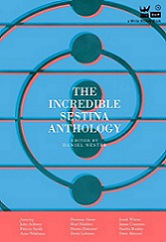
I don’t remember where or when I first encountered Daniel Nester and his work. But I do recall taking special interest when he announced that his sestina anthology project had found a publisher, and I knew that this book would be one I’d want to share with all of you.
Daniel Nester is the author of HOW TO BE INAPPROPRIATE and GOD SAVE MY QUEEN I and II. His writing has appeared in N+1, THE NEW YORK TIMES, THE MORNING NEWS, THE DAILY BEAST, THE BEST AMERICAN POETRY, THE BEST CREATIVE NONFICTION, THIRD RAIL: THE POETRY OF ROCK AND ROLL, and NOW WRITE! NONFICTION. He teaches writing at The College of Saint Rose in Albany, N.Y.
Please welcome Daniel Nester!
Erika Dreifus (ED): Your introduction to THE INCREDIBLE SESTINA ANTHOLOGY begins this way: “First things first. You’re asking: Why in the world should I read a book of sestinas?” I’ll paraphrase for my own first question: “Why in the world did you compile a book of sestinas?” And, on a related note: *How* did the book develop?
Daniel Nester (DN): I suppose my reflexive reply to the first question would be “why not?” A more serious one would be “because no one’s done it before,” by which I mean no one has put together a collection of sestinas in English, in the time of the great sestina revival-renaissance of the 20th century onward. There are collections of sonnets, villanelles, haiku; why not the sestina? As I say in the introduction, one of the reasons I remain fascinated by the sestina is that so many different poets from different schools and aesthetic backgrounds and impulses feel the need to try on the sestina form. It’s a democratic form in the best sense of the word.
The book developed over time, from when I was McSweeney’s Assistant Web Editor for Sestinas in 2003. I had a full working manuscript by around 2006, and did the whole book proposal thing–I shopped it around to about 15 publishers, some of whom turned it down nicely, others more unceremoniously. Soft Skull Press, then my publisher, didn’t have any interest. For a year or two there, especially when our kids were born, the book was back-burnered. But then, as these things happen, I sent out a final, Hail Mary pass round of queries, and Write Bloody Publishing enthusiastically signed on.
ED: In my experience, some editors are decidedly uninterested in poems or short stories about writing or writers. But I note a number of sestinas in this anthology that are, in some sense, about sestinas (Dana Gioia’s “My Confessional Sestina,” Donald Hall’s “Sestina,” Brian Henry’s “Bad Apple.”) Any comment?
DN: I normally do hate writing about writing, at least in its current bloggy-blog air-kissy incarnation on the usual literary website-blogs. So much hand-wringing about how one is supposed to live one’s life as a Writer, as opposed to being a human being who is a writer. What I am attracted to is the ars poetica, a poem on the art of poetry (its literal Latin translation), and I think writing a sestina about a sestina is perhaps the most natural thing you can do–the sestina is, for many modern readers, a postmodern form, a form that is so ridiculous and elaborate it has become a “form,” a form that’s hard to ignore inhabiting in as one reads it. So why not make it more obvious by having, say, ostentatious end words? This pomo self-referential business is not without precedent or synonyms: rappers often write about the art of hip-hop, so I don’t see much of a difference there. Gioia’s sestina about hating sestinas, while not my favorite sestina in this category, is nonetheless a notorious entrant, especially since he includes his workshop-bashing as well, which is sort of what made him famous back when he came out with “Can Poetry Matter?” in the early 1990s.
ED: End words, or terminations, are obviously essential in sestinas. I was intrigued by Elizabeth Bishop’s comment to Marianne Moore, quoted in the anthology, that there are “two ways possible” for a sestina: “one is to use unusual words as terminations…[a]nd the other way is to use as colorless words as possible…so that it becomes less of a trick and more of a natural theme and variations.” Care to comment?
DN: I love both tendencies, the natural and the unusual word approach. Both require a certain amount of mastery. As a sestina writer, I have erred on the side of the colorless word approach, with greater and lesser degrees of success.
ED: What was the most challenging aspect of getting this book from idea to publication?
DN: The permissions-getting would have been impossible without taking on a permissions coordinator, and Fred Courtright is the best in the business. He knows what he’s doing, he was so kind and generous. He was like a permissions doula while I was giving birth to this thing. The proofreading was the real challenge. The first proofreader we had didn’t even look at the originals–she just cold-read the poems as if they were new works or something–and it went into pages like that. Total nightmare. I hired an outside proofreader to get everything right, and we did. But it was…let’s say it was challenging and leave it at that.
ED: The book was published last fall. Please tell us a bit about how it has been received.
DN: There have been some classroom adoptions, and I’m Skype-visiting some classes this semester, as well as visiting some schools in person. My Poetry in Performance class will perform sestinas as one of their assignments. We got a nice article in the Albany Times Union and The Chronicle of Higher Education. Good word of mouth and some reviews coming up in the future. Sometimes I have to pinch myself when I think about all the contributors who are coming out to read their sestinas, all together in one place. I usually pinch myself six times, in spirit of sestinas.
ED: Thanks so much, Dan.
 Please visit http://www.incrediblesestinas.com to learn more about this “incredible” anthology!
Please visit http://www.incrediblesestinas.com to learn more about this “incredible” anthology!
My thanks to Dan and Write Bloody for the complimentary review copy.
A version of this Q&A appeared in the April 2014 issue of The Practicing Writer.